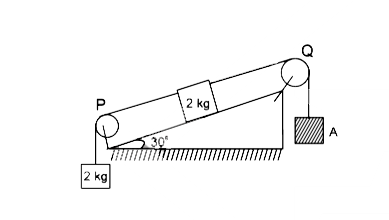In the arrangement shown in figure what should be the mass of block A, so that the system remains at rest ? Neglect friction and mass of string.

mAg=(2)(g)+(2)gsin30∘ asa=0
mA=3kg
Topper's Solved these Questions
- LAWS OF MOTIONBOOK - DC PANDEYCHAPTER - LAWS OF MOTIONEXERCISE - Exercise 8.3
8 Videos
- LAWS OF MOTIONBOOK - DC PANDEYCHAPTER - LAWS OF MOTIONEXERCISE - Exercise 8.4
3 Videos
- LAWS OF MOTIONBOOK - DC PANDEYCHAPTER - LAWS OF MOTIONEXERCISE - Exercise 8.1
10 Videos
- KINEMATICS 1BOOK - DC PANDEYCHAPTER - KINEMATICS 1EXERCISE - INTEGER_TYPE
15 Videos
- LAWS OF THERMODYNAMICSBOOK - DC PANDEYCHAPTER - LAWS OF THERMODYNAMICSEXERCISE - Level 2 Subjective
18 Videos
Similar Questions
In the arrangement shown in figure, what should be the mass of block A so that the system remains at rest. Also find force exerted by string on the pulley Q.
(g=10m/s2)

View SolutionIn the arrangement shown in fig neglect the masses of pulleys and string and also friction Calculate acceleration of blocks A and B

View Solution
Knowledge Check
In the arrangement shown below, pulleys are mass-less and friction-less and threads are in-extensible. Block of mass m1 will remain at rest if :
 A4m1=1m2+1m3Bm1=m2=m3C1m1=1m2+1m3D1m2=2m2+3m1
A4m1=1m2+1m3Bm1=m2=m3C1m1=1m2+1m3D1m2=2m2+3m1Find the maximum value of (m//m) in the situation shown in figure so that the system remains at rest. Friction coefficient of both the contacts is μ , string is massless an pulley is friction less.
 Acosθsinθ−μcosθBsinθsinθ−μcosθCμcosθsinθ−μcosθDμsinθ−μcosθ
Acosθsinθ−μcosθBsinθsinθ−μcosθCμcosθsinθ−μcosθDμsinθ−μcosθIn the arrangement shown in the figure, mass of the block B and A is 2m and m respectively. Surface between B and floor is smooth. The block B is connected to the block C by means of a string-pulley system. If the whole system is released, then find the minimum value of mass of block C so that A remains stationary w.e.t. B. Coefficient of friction between A and B is μ.
 AmμB2m+1μ+1C3mμ−1D6mμ+1
AmμB2m+1μ+1C3mμ−1D6mμ+1
Find the acceleration of the block of mass m in the arrangement shown in the following figures. The masses of the pulleys and the threads, as well as the friction are assumed to be negligible.

View SolutionIn the arrangement shown in figure the cylinder of mass M is at rest on an incline. The string between the cylinder and the pulley (P) is horizontal. Find the minimum coefficient of friction between the incline and the cylinder which can keep the system in equilibrium. Also find the mass of the block. Assume no friction between the pulley (P) and the string.

View SolutionIn the arrangement shown in the fig. all pulleys are mass less and the strings are inextensible and light. Block A has mass M.
(a) If the system stays at rest after it is released, find the mass of the block B.
(b) If mass of the block B is twice the value found in part (a) of the problem, calculate the acceleration of block A.

View SolutionTwo blocks A and B of equal masses are attached to a string passing over a smooth pulley fixed to a wedge as shown in figure. Find the magnitude of acceleration of centre of mass of the two blocks when they are released from rest. Neglect friction.

View SolutionIn the arrangement shown in figure, there is a friction force between the blocks of masses m and 2m. The mass of the suspended block is m. The block of mass m is stationary with respect to block of mass 2m. The minimum value of coefficient of friction between m and 2m is

View Solution
